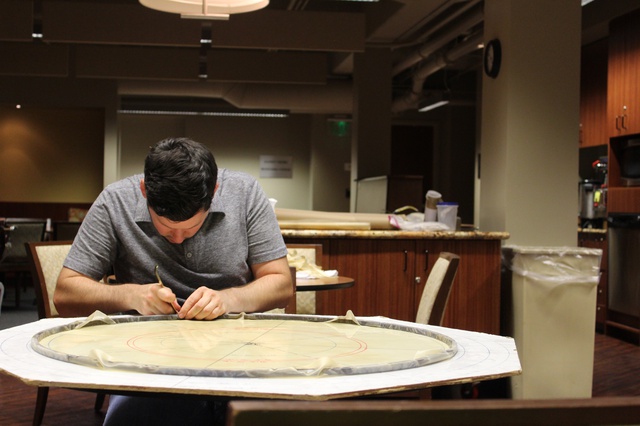In the Musicians' Lounge: Ryan DiLisi, principal timpanist

Our indoor season is right around the corner, and the Jacobs Music Center is abuzz with preparations by our staff, stage crew and, of course, our musicians. With 72 concerts to look forward to in the Downtown season, the month leading up to opening weekend is anything but a break for our orchestra members. From rehearsing to instrument maintenance, they log countless hours behind the scenes to ensure that every note they play onstage sounds just right. In our new series "In the Musicians' Lounge," we give you a glimpse into how our musicians spend their time offstage preparing to give you a concert to remember.
For our first installment, we caught up with principal timpanist Ryan DiLisi, whose preparation period involves manually rebuilding and replacing his drumheads so they are in pristine condition for the season. What you probably didn’t know? Those drumheads are made of calf skin. Vegans, proceed with caution…
Can you describe the process of replacing the calfskin heads on your timpani?
RD: The calf heads come from a company in Ireland, the oldest calf head producers in Europe, and arrive rolled up like wrapping paper. Each head gets soaked in water for about 20 minutes. Next, I lay the head out, measure and trace lines, cut off the excess, then "tuck" the head around a metal hoop. This means that I take the calf skin that extends past the hoop and, in 16 points, gradually wrap it around the hoop until it's wrapped around the entire circumference of the hoop. After that, I place the completed but still wet head on the timpani bowl, and leave it to dry for 48 hours, checking on it each day to make sure the playing surface stays wet while the rim dries. After it all dries, I then put the tension rods back on the drum and screw them down on the head, where I leave it for another day. At this point the new calf head is ready to be played.
How long does this usually take you?
RD: Tucking each head takes about an hour and a half; however I also utilize this time to clean the timpani thoroughly, and then I need to wait and do little "checkups" as the new head dries, so it ends up taking about 72 hours from start to finish.
Why do these heads need to be replaced every season?
RD: You may notice white blotches on the timpani heads. These are spots where I've been hitting the drum head, which then begins to wear out. Fortunately, you can rotate the calf head and use a new beating spot, so there are four areas on each head that can be used. As each area gets worn out, the sound begins to grow dull, the head loses resonance, and the pitch begins to become less in tune. That means it's time to rotate the head. After the 3rd beating spot, the heads typically begin to sound dull in general, so the final beating spot is usually a last resort option. Each beating spot lasts typically around two months, depending on the repertoire, so by the time we reach May, it's time for a new set of heads.
What makes calfskin heads special?
RD: Calf heads truly sound so much better than plastic heads. They have a warmth and richness in sound that is unattainable by any other product. Even the way that the mallet feels when striking the calf head feels better. On plastic, it feels like you're fighting with the head to get the sound out. Calfskin envelopes the mallet, cushioning the attack.
Do you have any additional fun facts about your instrument?
RD: When you see me leaning over the drum head during concerts, what I am doing is tuning the timpani. Each drum has a pedal that changes the pitch, so I'm leaning down close to the head to sing the note I need into the bowl. When I've reached the right spot on the pedal that will match that note, the entire drum head vibrates and "sings" the note back to me.
This also means that yes, the timpani are pitched instruments. Timpani music is written in bass clef, and has specific pitches that you're required to play. While most music before the 1900's only required two pitches, contemporary music requires the timpanist to change the pitch all the time, often at the same time that I'm playing. This requires muscle memory of the pedals and knowing generally where the notes are located.
What piece are you most looking forward to playing this season and why?
RD: I absolutely love Respighi, and in January we are playing two of his works in one concert. Pines of Rome is an absolute favorite, brilliantly bringing to life scenes from Rome's past. And La boutique fantasque contains piano melodies written by Rossini in his retirement that Respighi later took, orchestrated and turned into a ballet. It's whimsical, fast paced and lyrical in a way that only two Italians born 100 years apart could achieve.
I also love John Williams' music, and we continue our cycle of performing all the Harry Potter films this season with The Prisoner of Azkaban. This is the last Harry Potter film that Williams scored, so I am very excited to perform that in February.
In your opinion, what makes this downtown season special?
RD: We have such a varied mix of music this season. There truly is something for everyone, whether you're interested in classical, pops, jazz or crossover events; every style is highlighted at some point. We also continue our music director search, which will see returning faces and plenty of new ones as well. It is such an exciting time for our symphony, and I think it's palpable in the audience.
Keep an eye out for future installments of "In the Musicians' Lounge" for more behind-the-scenes fun facts and sneak peeks!
Post written by Stephanie Zumwalt, Marketing and Public Relations Coordinator for the San Diego Symphony.
Share ArticleBack to all posts
